April 19, 2009
Today is our local Avocado Festival. I don’t plan to go this year. My spouse went very early, before the crowds arrived, for some fresh produce and a carne asada burrito.
I would’ve titled this post with the name of the actual festival we had here in town today, except that I’m going to criticize it a little bit, and I don’t want to cast a shadow over that particular event for any locals who otherwise enjoy it. My criticism isn’t about just our Avocado Festival.
The positive side is, I’m eating a strawberry. That’s always a good thing. In fact, I’m rich today, with three little baskets of strawberries and a good week or two’s supply of avocados. Not only that, we got some of the avocados for free, from a local business near one of the avocado packing plants. Presumably they’re cast offs from the preparation for the festival, since they aren’t very pretty ones. But they’re still delicious, and dead ripe, so I already got to enjoy some for breakfast. My favorite way to eat avocado is mashed with salt and pepper and spread on toast. Since I live with my favorite bread baker, this is the ultimate easy (for me) and delicious breakfast.
My rant is not about the immense crowd that will be there later today, even though I’m not a crowd person. I can handle crowds, and even enjoy them, in small doses. My rant is not about the local vendors who show up each year. It’s not even about the non-local vendors who show up there. After all, everybody’s got to make a buck, right? Some of the vendors are wonderful.
You can get the best local tacos, tamales, and burritos at our Avocado Festival that you’ve ever eaten, and there’s always a nice supply of fresh avocados, of course. Then there’s the standard fair fare, funnel cakes and lemonade and . . . well, the list goes on. We don’t buy most of that standard fair food, so I’m not even aware of what it all is. We usually go for the Mexican food. Some of it’s not available year round, even here, because it’s from groups or businesses that put out a special effort just for the festival. It’s a rare treat, and one of the great draws of the festival for us in the years we attend.
In the years that we attend, we’ve learned to walk there early, as soon as the booths are opening. That way we avoid the biggest crowds and the worst heat.
I’m not sure why, but the day of the Avocado Festival is always hot, even though we can get some pretty cool weather in April. Three days ago we had a high of something like 67 degrees Fahrenheit and the nighttime temp dipped into the low 40s. I wore long sleeves all day, and sometimes a sweater. Yesterday the high was over 80, and today promises to be at least that. (Update, it got up to 93 in town today!) But as usual, of those two weather patterns, the festival happens to fall on the warmer day. Or should I say the warmer day happens to fall on the festival day — the festival was planned well in advance.
Because of the heat and the larger size of the crowd later in the day, and some combination of those factors that seems to make everyone tired and cranky by afternoon, the feeling of the late day crowd changes in a way that becomes distinctly unpleasant for me. So if I don’t go early, I’m not likely to go at all. In fact, I’d just as soon the booths opened at six in the morning rather than nine.
What bothers me about the festival is now fairly universal, I suspect, to local festivals and fairs all over the country. There are very few locals selling handcrafts and artwork anymore. Many of the vendors that sell non-food and non-produce items — and some of the food vendors as well — have traveled from other places. Some of them make the rounds of, possibly, every local festival and county fair in the state, and maybe more than one state. Some are from industry, manufacturers’ representatives selling things like secure mailboxes and automatic sprinkler systems, the sorts of things you expect at home shows and trade fairs, not unique to an Avocado Festival. Some are selling manufactured clothing and home decoration items that I can buy at a department store or a swap meet. The traveling vendors have always been around, but lately they seem to be the only ones. Where are the locals? To me this trend of increasing numbers of non-local vendors is like finding the same chain restaurants everywhere you travel. That used to disappoint me when traveling on business. If there’s any perk to having to take business trips, it’s discovering local eateries that are unique to the city you’re visiting. But if you travel to another place only to eat at Outback or Chilis, you might as well have stayed home. Why go to the local festival to buy the same items that will be sold at the county fair two months from now? More importantly, why go to find items you can buy at the department or hardware store? The point of a local festival, I thought, was to find things that can be found in only one place, to celebrate that location’s unique qualities and products.
I’m glad that we still have some local businesses that sell food and a few other items there. In the years I attend, if I go early, I can pick and choose which places to visit, and I usually enjoy myself. But I miss the kinds of things we used to see more of and that I always loved festivals and fairs for: handcrafts, local artists’ work, and those really unique and unusual items that once were only found at local fairs. They seem be rare these days, almost extinct.
I’m sure there’s a reason for this. Perhaps it has to do with the process of arranging to sell at one of these events, that it’s become so business-oriented that it shuts out local artists and craftspeople. Perhaps people don’t have time anymore to make things themselves and arrange to sell them locally unless that’s their full time business. If it is their full time business, they likely have to travel from fair to fair to make it pay off year-round.
We see some of those traveling vendors selling beautiful things, like handmade herbal soaps, stunning hand-carved gourd art, and some unique pottery. It’s great stuff, and I’m glad it’s there. But, whatever the reason it’s not there, I still find the lack of local handcrafts and artwork at these events sad. I know some of the vendors hate it when I ask, “Are you from around here?” But I continue to ask. It doesn’t mean that I won’t buy what they’re selling, if I love it and can afford it. But I can’t help being more enthusiastic about finding local goods that I love at our local festival.
The only other rant I have is, where are the hats? This is the time of year our warm weather sets in. In the past I’ve arrived at the festival only to wish I’d brought a hat. I can’t be the only one. There used to be hats for sale all over the place there. I usually bought my hat there to use for yard work or walking around in the sun for any reason, because it was the right time of year and they had a nice selection for good prices. Last year I hardly saw any hats. Maybe they were there and so few that I never came across them. I hope at least the hats were back this year.
Last year, too few local handcrafts, too few hats. This year I’m not going to the festival. Can anyone connect the dots?
Maybe the real problem is that I’m not like other people who attend. Maybe most people prefer mass-manufactured, universally available things. Who knew that would become the major draw of a local festival? Maybe it’s just me.
In any case, I’m happy for the strawberries and avocados. It’s a good day.
July 8, 2008
Our summer weather has set in, likely until mid to late October, so I have to wake up early to get all my outdoor work done. I’m amazed how fast things can grow in the warm weather and get away from me — mostly things I don’t want to grow, like weeds.
My usual care to wear gloves when working in the yard had lapsed recently, but working outside earlier than usual this morning meant that I happened across two black widow spiders. One, on the lower rock wall, was attempting to kill a big iridescent green June Beetle, or what we call a June Beetle here, aka Fig Eater Beetle. The beetle was 10 to 15 times the spider’s size. Their struggle mesmerized me for a moment as I wondered who would win, the beetle snapping spider silk as quickly as it wrapped around it. It was the noise he made that drew my attention in the first place. I would’ve intervened, if I’d had something handy to kill the spider with, but the next time I walked past, the spider — hiding from me, no doubt — was nowhere to be seen and the beetle was bumbling away. I’ll be more careful to wear gloves and not work in flip-flops anymore, unless I’m only watering. Black widows usually hide from people, but I don’t want to surprise one.
My little friend Tara is growing fast. A kitten in the house means lots of interruptions to play, or to stop misbehavior in its tracks, or just to cuddle. I’ll try to post an updated photo later, but it might be a blur unless I catch her when she slows down to nap, bask in a sunny window, or watch TV. She’s now more than three times the size she was when I took these pictures, and darker since her kitten fluff has been replaced by a true dark tabby coat. She’s a Siamese mix, but you wouldn’t know that to look at her.
Tara watched Mikhail Baryshnikov dance, in an older video on the arts channel last night, and I think she decided he’s the most cat-like human she’s seen. I hope she doesn’t expect us to move like that! But maybe it’s good that she knows some humans are capable of it, just to help us keep the upper hand. Sometimes we call her Rocket Cat, and one day recently, as the dog and I watched in glazed over amazement while she raced around and up and down a room, I commented to him, “You know, cats can almost fly.” Indi seemed to agree.
I’m not really sure what all else keeps me busy, but there’s a lot of it, whatever it is. I don’t work in the garden enough to excuse not blogging, but I do spend some time finding things to do with the excess produce.
We’ve had loads of squash from just four plants, so far, some of it now in the freezer and some given away. We may need a bigger freezer if I keep gardening. One way that we like zucchini is simply sautéed in a little olive oil with basil, oregano, salt, and pepper. We’ve had some cucumbers, which I personally think would make a good breakfast food, because just one bite seems to wake me up with its fresh, clean crispness. The tomatoes got a late start (from seed), so we haven’t had any to eat yet, but they’re blooming and setting fruit, growing like mad in the heat. There’s a San Marzano Roma about the size of the end of my thumb that I predict will be the first to the table, unless that little cluster of marble sized cherry tomatoes beats it to perfect redness. With the salmonella scare still pretty much a mystery I’m looking forward, even more than I expected when I planted them, to fresh homegrown tomatoes.
Yesterday we discovered how well extra garden produce can pay off, when we gave a large zucchini to a neighbor boy to take home, and later his mom sent over four of the most perfect little quesadillas I’ve ever tasted. Oh. My. God. These were not the quesadillas you find in Mexican restaurants, or the floppy things we usually concoct with flour tortillas and cheddar cheese, in a skillet. Every part of hers was homemade, including flaky six-inch corn flour shells folded in half and crisped. They were filled with chicken, some kind of white cheese, possibly one of the Mexican cheeses described here, and fresh cabbage, and they came with a magical homemade chili sauce to pour over them. I am positive we got the better end of that exchange. You can’t get food like that in any restaurant, and I’m in heaven just remembering them. It’s odd how a really good hot sauce can actually cool you. As my mouth heated up, my body seemed to cool right off. Must’ve been all my pores and sinuses opening. It was positively delicious. Mmmmh!
May 30, 2008
Mystery author Eric Mayer* mentioned in a recent blog post that his blog journaling hasn’t been very habitual of late. He went on to write about habits, and that got me to thinking about my habits, and how they’ve changed in the past year or so. Obviously, for me, blogging has taken a back seat to other things. So has my fiction writing, other than attempting to sell my latest finished manuscript, a mystery about a tarot reader whose awakening ability as a medium gets her involved in a murder investigation. (Interested agents or publishers are welcome to inquire here.)
Habits can be good or bad, and I’m sure everyone has some bad ones they’d like to unload. But one new habit I’m happy to have taken on this year is gardening.
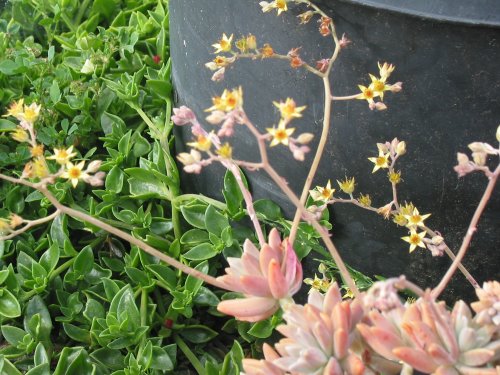
Gardening is indeed a habit, one that gets into your blood in a way I didn’t anticipate when I started out this year. I’d done a tiny bit of gardening as a kid, when I remember planting one rose bush of my own but mostly helping my grandmother with her strawberries and vegetables on the embankment behind my parents’ house. Later, in my first apartment, I nurtured a few houseplants, and throughout my work life I’ve usually kept a potted plant on my desk. I kept African Violets in a north facing window in the last house we rented, until a cat took over that window sill. Still, my husband did most of the outdoor gardening, with a little weeding here and there on my part, until March of this year.
It started this spring with tending a few vegetable and flower seeds until they sprouted, and then the seedlings until they went into the ground. From there I progressed to caring for plants in the ground and preparing the soil for more of them. It’s rapidly expanding to a succession of all of these things, in the hopes of keeping some fresh produce in our salad and veggie bowls through this summer, as well as brightening a corner of the front yard, where my ultimate goal is to keep flowers blooming in a little cottage style bed year round. I’m a ways from that goal yet.
I’m still new at this, and I got a late start this year, but I get help and advice from various sources, and gardening is now a firm habit that I won’t easily give up. It’s one of the first things I think about in the morning and one of the last I think about before the sun goes down.
The plants seem happy about my gardening habit, when they can figure out what season it is. Our weather this spring switched back and forth for a couple of months from one extreme to the other, first dry Santa Anas with temperatures in the 90s, and then thick cloud cover and a shifting Jet Stream chilled the air to the 50s. This went back and forth for weeks, with little pleasant weather in between, and it kept our plants confused. In the past two weeks the weather has leveled off, and the plants are loving it.
They say beauty is in the eyes of the beholder, and I’ve recently realized there’s little more beautiful to me than a tiny plant bursting out of its seed container. Call me crazy, but I think baby plants can be almost as cute as a kitten, and they, like the kitten, draw out my mothering tendencies.
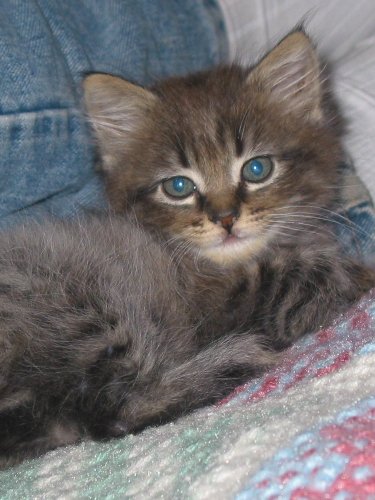
(I’ll bet you expected a photo of a seedling, but I couldn’t help the obligatory kitten shot.)
To some this pleasure might seem like taking joy in watching paint dry, but to me it’s more like watching a sunset at the end of a heat wave.

We celebrated our first avocado blooms a few months ago.

Now some fruit has set, which we hope will grow to maturity.
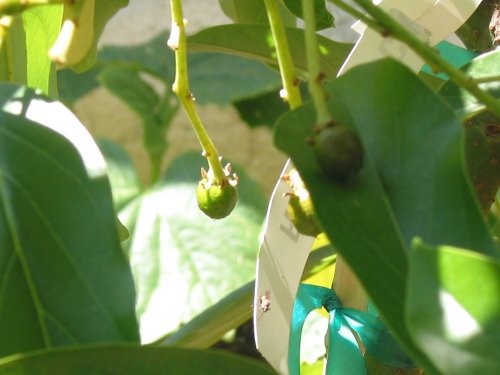
Avocados, according to my resident expert Ken who’s read something like 200 online agricultural reports about them, tend to drop a good portion of their fruit early, which can be disappointing to home gardeners. It will be disappointing to me, if it happens, because Reeds are my absolute favorite avocado variety.
Two days ago I celebrated my first squash blossom.
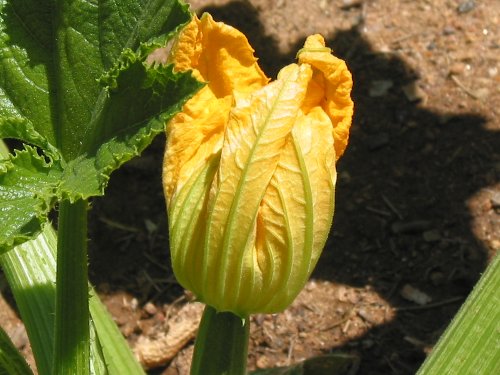
Zucchini may seem an ordinary thing to seasoned gardeners. It’s one of the easiest things to grow and the butt of gardening jokes, usually in reference to an overabundance of it. But I like zucchini, I love my resplendent squash plants with their huge green leaves, and those yellow-orange blossoms are gold to me.
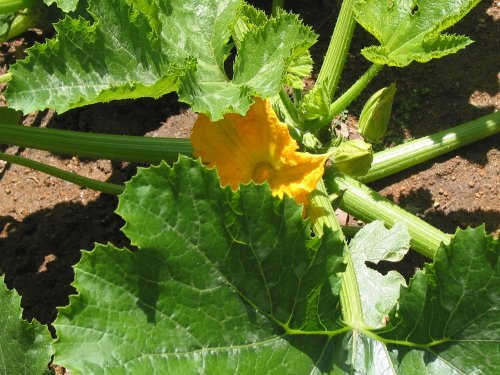
I’m learning more about the various weeds that grow in the garden, some of which are edible. For instance, purslane and dandelion make delicious salad greens. Note, if you decide to try eating weeds from your garden, be careful that you know what you’re eating. Ensure that the plants haven’t been subjected to herbicides or pesticides and that they aren’t in fact toxic weeds.
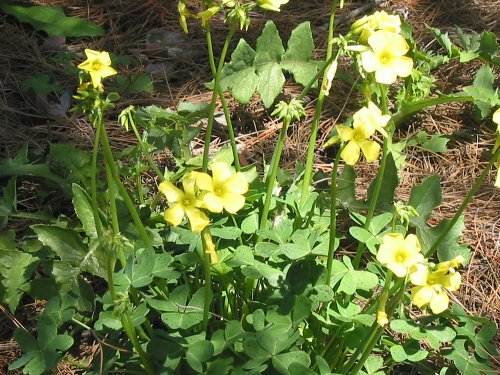
Even some semi-edible weeds, like the sour grass we all discovered as kids, can be a problem if eaten in quantity, I’m told, and purslane looks very similar to a toxic type of spurge that often grows right alongside it. Have an expert show you how to identify edible weeds, and examine carefully whatever you pick to eat. This point was driven home to me when I found spurge, with its milky sap, growing in my own little purslane patch.
Yesterday Ken pointed me to a Los Angeles Times article about Guerrilla Gardeners, which linked to a slide show on how to make “seed bombs” as well as two blogs, here and here, about guerrilla gardening.
Gardening has not only revolutionized my daily routine. It’s apparently a revolution that’s spreading once again, as Victory Gardens did in the last century, with people today gardening to save money on local food and working on a clandestine volunteer basis to re-green the land.
_ _ _
* In case you aren’t aware, Eric Mayer and Mary Reed’s latest John the Eunuch Byzantine mystery, Seven For A Secret, was released in April by Poisoned Pen Press. If you haven’t kept up with their historical mystery series, it’s not too late to start. The earlier books in the series are still in print, and some are now available as Kindle editions.
August 18, 2006
After air to breathe, it’s the next priority. We tend to take it for granted. Rhubarb pointed out this article, in which some corporate experts predict economic problems “by 2015 as the supply of fresh water becomes critical to the global economy.”
Thinking about water shortages reminded me of the first business trip I made to Philadelphia. I wondered if Pennsylvania was always that green, or if it was possible the trees and grass were putting on a special show that summer. I recall experiencing the same amazement at the greenery of Western Oregon and Maryland, almost a distrust of so much verdure. It is never that green here. Even with the vast Pacific Ocean beside us, the nearest we come to that quality of green in Southern California is a dusty, grayish imitation in parks, and that in El Niño years. Our water is imported, much of it from the Colorado River, which is so strained by use that it dwindles to a mere trickle where it meets, or used to meet, the ocean in the Gulf of California. These days the spent river disappears somewhere in Mexico. The rushing torrent that carved the Grand Canyon, and spilled over in flood years to fill the Salton Sea, becomes no more than a creek trickling through irrigation culverts into thirsty Mexican farmland. According to U.S. Water News Online:
The valley along the river south of Mexicali produces roughly 10 percent of Mexico’s wheat, about 17 percent of its cotton, and important quantities of sorghum, alfalfa, and asparagus. Even when there are heavy rains upstream, a few steel culverts under a gravel road can handle what was once called “an American Nile” as it limps toward its mouth in the Gulf of California.
In dry years, the river is devoid of water. Between 1961 and 1978, when reservoirs were slowly filling behind upstream dams, there was almost no water in the lower channel at all.
Recently I read a collection of essays and stories by West Texas women, Writing On The Wind. The emphasis on drought, the importance of windmills, the quality of water in some places (one woman had lived in a house where her toilet bowl was perpetually stained black) carved impressions in my mind. I recognized, even if I’ve known it to a lesser degree, the disorientation and distrust of an unfamiliar abundance of green that West Texans feel when traveling to wetter places.
My limited travels and that book served as stark reminders of what a precious commodity water is. While those reminders centered in the wealthy US, where money so often manages to truck or pipe water where it’s needed, the world as a whole has a more tenuous claim on fresh water to begin with. If the shortage is worsening, we may all be in trouble soon.
February 10, 2006
Vikk at Down the Writer’s Path tagged me for the Four Meme.
Four jobs I’ve had:
1. Library Reference Room Page
2. Editorial Assistant
3. Technical Writer-Editor
4. Novelist
(more…)
January 22, 2006
Rhubarb tagged me to post my response to this meme.
Five Weird Habits: (more…)
January 17, 2006
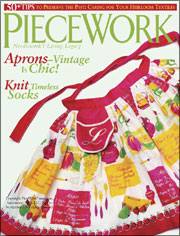 The latest issue of Piecework features vintage aprons, including a collection with themes like Visit to Grandmother’s Farm, and Cycle of Life. My favorite is the peridot green gingham with cross-stitch embroidery depicting the Eternal Question, “Which came first, the chicken or the egg?” Aprons remained in vogue during the entire first half of the twentieth century, when most women worked at home. Sometime during the sexual revolution, aprons lost favor, except for men working the outdoor barbeque, proud of their culinary skills, pleading for kisses as rewards.
The latest issue of Piecework features vintage aprons, including a collection with themes like Visit to Grandmother’s Farm, and Cycle of Life. My favorite is the peridot green gingham with cross-stitch embroidery depicting the Eternal Question, “Which came first, the chicken or the egg?” Aprons remained in vogue during the entire first half of the twentieth century, when most women worked at home. Sometime during the sexual revolution, aprons lost favor, except for men working the outdoor barbeque, proud of their culinary skills, pleading for kisses as rewards.
A lot of changes took place during that time. In the course of just ten years, my siblings and I went through big changes in what clothing was acceptable, and who was expected to make it.
When my oldest sister was in junior high school, she came home one day upset because her friend had been sent home for her skirt being too short, a crime proven by use of a ruler. My guess today is that either the fabric shrank in the wash, or she’d gone through a sudden growth spurt in the legs. After all, she wasn’t “that kind of girl.” In high school my oldest sister belonged to an organization called Future Homemakers of America. Many of the girls who belonged made their own homecoming and prom dresses. One girl in my sister’s class earned the reverence of her peers when she stitched hers completely by hand. (more…)








 The latest issue of Piecework features vintage aprons, including a collection with themes like Visit to Grandmother’s Farm, and Cycle of Life. My favorite is the peridot green gingham with cross-stitch embroidery depicting the Eternal Question, “Which came first, the chicken or the egg?” Aprons remained in vogue during the entire first half of the twentieth century, when most women worked at home. Sometime during the sexual revolution, aprons lost favor, except for men working the outdoor barbeque, proud of their culinary skills, pleading for kisses as rewards.
The latest issue of Piecework features vintage aprons, including a collection with themes like Visit to Grandmother’s Farm, and Cycle of Life. My favorite is the peridot green gingham with cross-stitch embroidery depicting the Eternal Question, “Which came first, the chicken or the egg?” Aprons remained in vogue during the entire first half of the twentieth century, when most women worked at home. Sometime during the sexual revolution, aprons lost favor, except for men working the outdoor barbeque, proud of their culinary skills, pleading for kisses as rewards.
